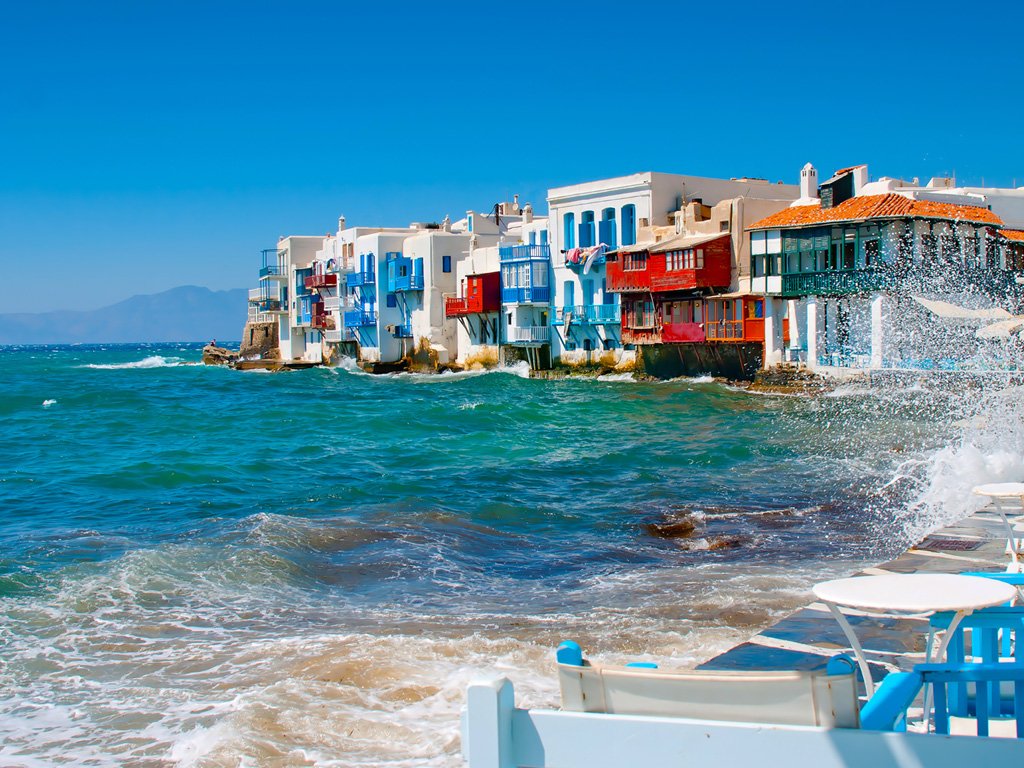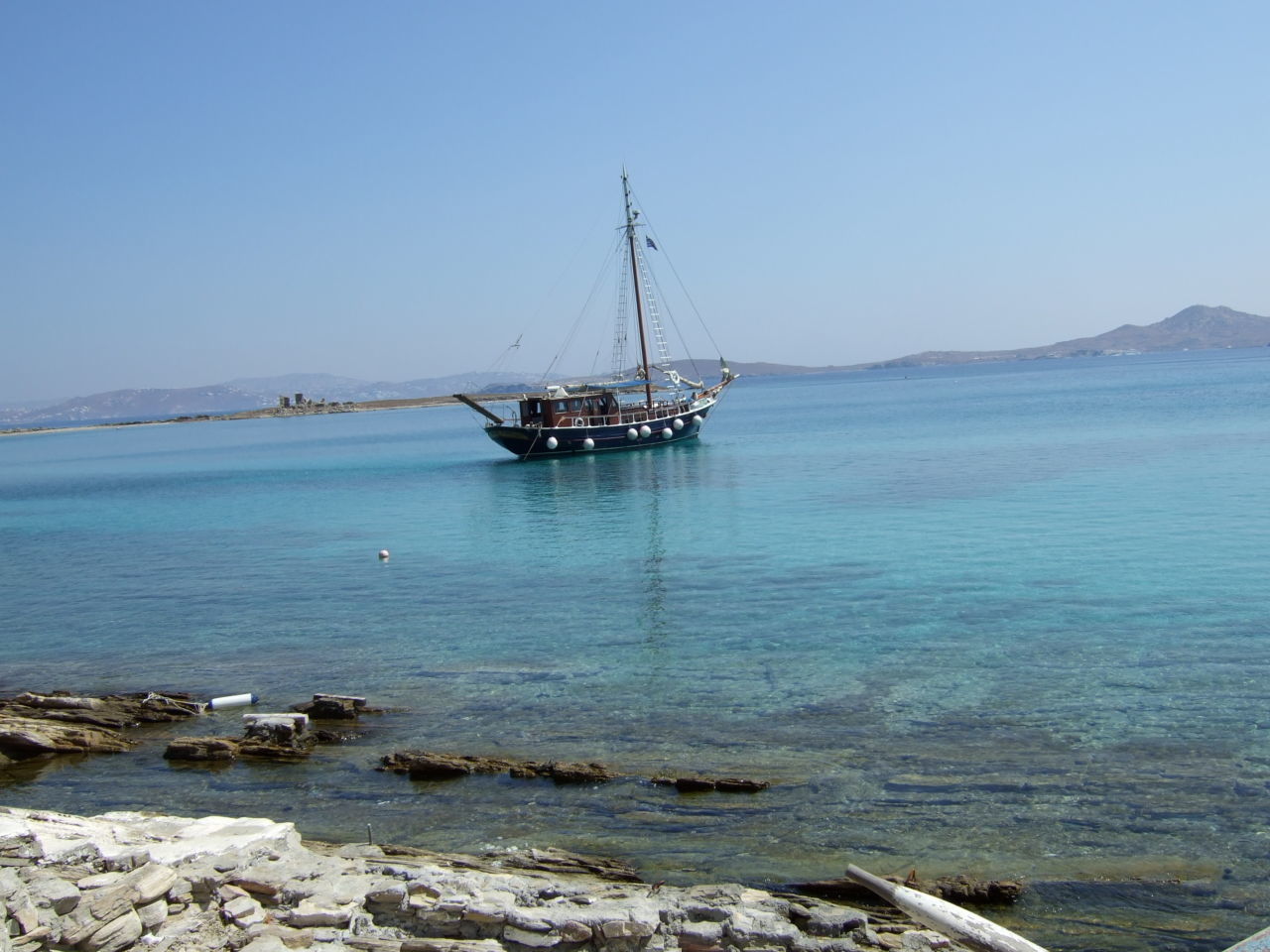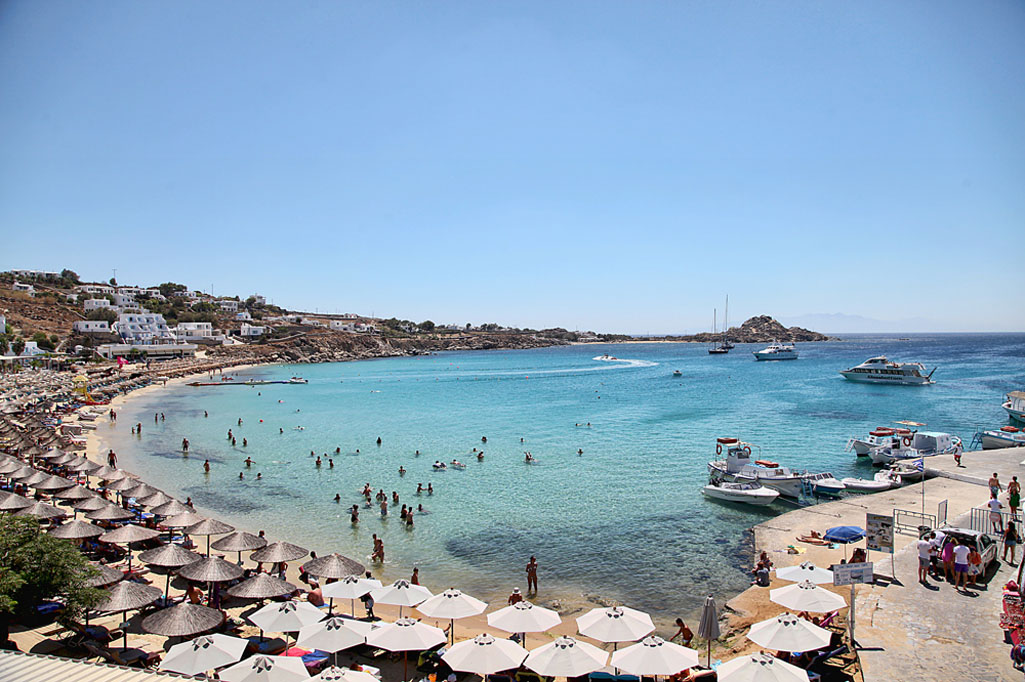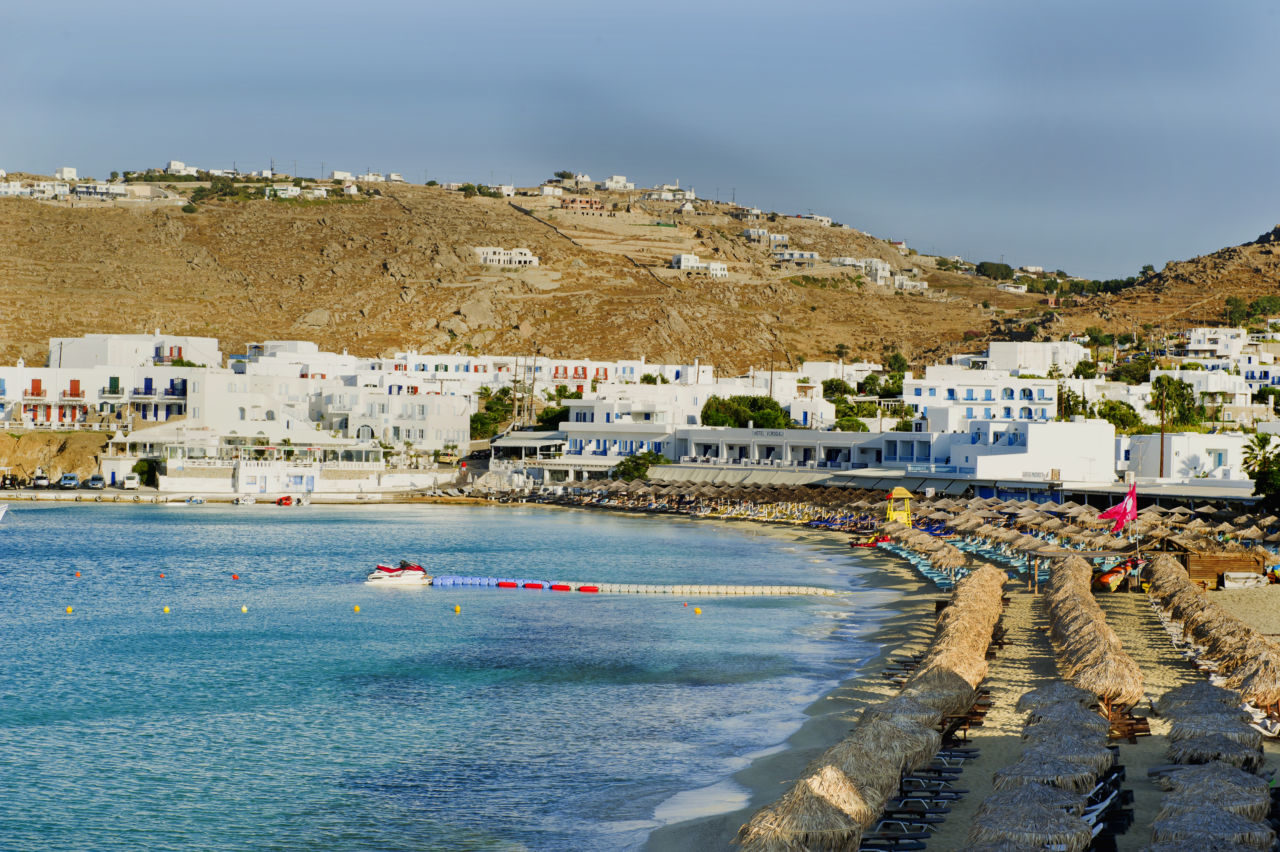By: AURELIA, Contributor
INTRODUCTION
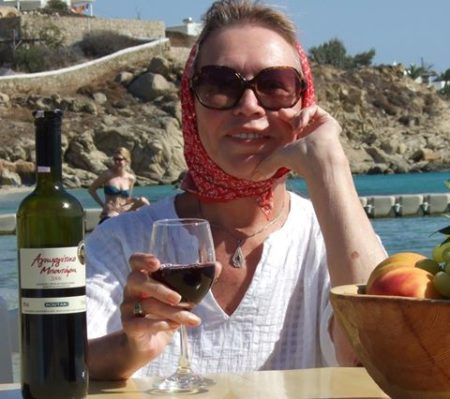
Perhaps this tension is best exemplified in the islands that form an ancient triangle in the very heart of the Cyclades. They are cosmopolitan Mykonos, Sacred Delos, and mysterious Rhinia. Taken together, these sisters with their distinctive and contradictory personalities give the visitor a tantalizing taste of Greece known only to the Greeks.
Within this triangle, one can sun bathe nude or topless on some of the most beautiful beaches in Greece, literally dance until dawn at discos, take a magical, chartered cruise through the islands, go back in time with the ancients on an island declared “sacred” by the Greek government, or spend an enchanted day alone on an uninhabited island where gentle waves caress a pristine shore, luscious watermelons hang from vines, and where the pure air is so still you can hear yourself breath.
MYKONOS
The sometimes naughty sister, Mykonos, is famous world-wide for its chalk-white beauty and its vibrant nightlife. Celebrities and dignitaries from all over the world make this island a destination to shop, sun bathe, party, and island hop, and cruise ships from all over the world come here. It is not unusual when walking through the white-washed streets of the town center, called Hora, to see a world famous model or movie star gazing into a jewelry store while munching on a cheese pie, looking very much like Audrey Hepburn in “Breakfast at Tiffanys.” The glorious golden and jewel-studded rings, earrings, bracelets, and necklaces displayed in the windows of the artisans of Mykonos bedazzle even the most sophisticated celebrity.
Many artists consider Mykonos town itself a work of art. Its white homes resemble sugar cubes and all the winding alleyways and joints between the paving stones are painted chalk white. The fishing harbor is small with brightly colored caiques bobbing about in a sea so blue it looks like a postcard. If artists had been asked to design this town, they would have added domes and crosses from churches to the silhouette of cube-like homes, and then added windmills for a picturesque contrast. But it was ordinary people who allowed Mykonos to grow in a natural way and it was these Mykonians who did, in fact, add the domes and crosses and windmills over the years. Some say these “ordinary people” were the island’s first artists.
Mykonos is sometimes called “Little Venice” or “The Capri of Greece.” It is considered by many to be the most cosmopolitan and sophisticated of the Greek islands and offers the very best in accommodations, food, and ambiance to the visitor. Perhaps nowhere else in Greece can one find gold jewelry as fine as that produced by the artisans of Mykonos. This is due in part to the fact that in the 12th to 15th centuries Venice ruled the island and the Venetian influence is seen today in the distinctive jewelry.
Mykonos is pleasing to the senses. Its brightness will dazzle you and its pleasures enchant you. Mykonos, the temptress, will seduce you with her charms.
DELOS
If Mykonos represents secular pleasures sought by the jet set, Delos is its opposite and is the most sacred of the Greek islands. At the very geographical center of the Cyclades, Delos is its spiritual center as well and was the religious, cultural, and commercial focal point of ancient Greece. It was the jewel of the ancient world, a thriving commercial hub, and the “summer home” of the rich and famous of the time. One can see Delos’ past glory in the magnificent ruins and in the exquisite, world-famous mosaic floors of the ruined palaces.
According to mythology, the god Apollo was born on Delos and is known as the god of the sun. Delos is drenched in sunlight and there are no high mountains or trees to provide shade. There is one palm tree, however, and it is said that this is where Apollo was born as his mother, Leto, leaned against the tree to give birth. Zeus, Apollo’s father, commanded the sea to create a wall of foam so that his wife, the jealous Hera, could not witness the birth.
In its day, there was no island in Greece as glorious as Delos; it was the true cultural, religious, and commercial center of Greece. Today, we would call ancient Delos the ultimate “destination point.” The island had an eclectic mix of mansions, temples, markets, stadiums, and shops, and one never knew who would suddenly turn up to visit or inquire about establishing a summer residence. Rumor has it that Cleopatra wanted to build a summer home there, but the residents voted against this.
RHINIA
The third sister is Rhinia, a haunting, mysterious island four times the size of Delos and separated from it by a small strait. Called alternatively “Great Delos” and “Big Delos,” Rhinia is really two sections connected by a narrow isthmus. It is four times the size of Delos. Both parts of Rhinia are uninhabited and by Greek law, no one is allowed to live on this island or build a permanent home there; there is no running water or electricity and there are no roads on its rocky, hilly terrain. (There are rumors, however, of a few hearty souls who make the island their home) Very few tourists know about the island or have an interest in going there on a day’s excursion, so, if you plan it correctly, it is possible to be the only person on one of its four pristine, sandy beaches.
Rhinia is an ancient burial ground and in the period of 416 to 425 B.C. it was home to women about to give birth and everyone else who was about to die. These poor souls were exiled from Delos when it was “purified” and declared sacred by the Delian Confederacy after a brutal battle. Because the island was “sacred,” no one was allowed to give birth or to die on the land. For centuries Rhinia was a refuge for pirates, but after the Greek War of Independence in 1821, it was ceded to its sister, Mykonos and is now part of the Cycladic Triangle.
The Cycladic Sisters, Mykonos, Delos, and Rhinia, each with her own personality, are among Greece’s most precious treasures. The visitor who ventures to the Cyclades will experience the sacred and the profane, the sublime and the absurd, the Ottoman and the Venetian, the glorious ideal and stark reality, the goddess and the temptress, the perfect beauty of the sun god, Apollo, and the wild revelry of the wine god, Dionysus. In short, the visitor will experience Greece.
MYKONOS—THE TEMPTRESS
Mykonos is the most popular and sophisticated holiday resort of the Aegean, and some travelers consider it the ultimate, cosmopolitan retreat in the entire Mediterranean. Luxury yachts from all over the world dock at its harbors, ferries arrive daily from Piraeus, Rafina, and Lavrion, and, with a new airport built a few years ago, more planes than ever before are now landing on the island. Mykonos has more bars, restaurants, and discos than most other Greek islands and the quality of the beaches, food, music, precious jewelry, and nightlife is second to none.
Mykonos is a Cycladic or “White” island and is part of a complex of thirty-three inhabited islands forming an imaginary circle around Delos in the Aegean Sea. In the Cyclades, homes are chalk white and cubical and most were built by anonymous “folk builders” using materials found on the island. In Mykonos, this approach to architecture has produced a town that is itself a work of art, a masterful collection of perfect, white-washed cubes that stand in dazzling contrast to the brilliant, blue sea.
The contrasts on Mykonos can best be seen early on a Sunday morning, between 6 and 8 am. Silently, worshippers returning to their homes share the streets with night people who have recently left the clubs and discos. Widows covered by traditional black dresses and head scarves pass young women scantily attired; each group stares in amazement at the other, saving their caustic comments for when they are safely out of earshot. A few men and women selling produce from their donkeys stand far from young rent boys trying to make one more score before the “night” ends. Music from nearby clubs plays softly, perhaps in deference to the hundreds of church bells tolling throughout the island.
Orthodox priests walk about in long, black robes that “swish-swish” as they dust the cobble-stones. Walking behind the priests giggling uncontrollably are tipsy drag queens with heavy make-up and orange-colored hair, their long gowns “swish-swishing” in unison with the robes.
Shopkeepers open their establishments early on Sundays. The visitor sees one of Mykonos’ famous icon makers and peaks into his studio. The walls are decorated with magnificent works of art in the Byzantine style, each an original, and beautiful icons of St. George and the Dragon and of the saints are on display. A few doors down the visitor comes upon a leather shop featuring expertly-made handmade leather handbags and sandals, side by side with harnesses, vests, gloves, and ominous-looking whips.
And then there is the sacred side of Mykonos. One of the architectural wonders on the island is Paraportiani, said to be the most photographed church in Greece. An architectural masterwork, it is a complex of five churches and was built over time during the 16th and 17th centuries, and perhaps earlier. All in all, there 500 churches on Mykonos, most of them small, private chapels attached to or near the homes of devout Mykonians. It is said that when the lives of the fishermen and other islanders were in danger while they were at sea, their lives would be spared if they vowed to build a chapel upon return to the safety of land. And that is why, the story goes, there are so many churches.
Mykonos covers an area of twenty-three square miles and has a population of about 15,000 permanent residents. The town itself is an actual maze and was deliberately built in this fashion to confuse pirates who came to rob and pillage. The maze makes the town even romantic and creates literal surprises around almost every corner.
In a typical home, a Mykonian woman sits beside her needlework or loom in a room sparsely furnished with simple yet artistic necessities. On the walls are icons and the floors are covered with hand-woven rugs. Outside, donkeys laden with baskets of produce are lead by Mykonians through the narrow, white-washed pathways as motor bikes with attached carts zip rapidly through the lanes to deliver supplies.
Petros, the pink pelican and good luck symbol and mascot for the island, wanders about. He is seen most often in the Alefkandra section, known as “Little Venice,” or in “Taxi Square” near the harbor front where the statue of Mando Mavrogenous proudly stands. She is the famous heroine who gave all her fortune to support her country during the 1821 Greek War of Independence.
The town is made distinctive by its huge, round windmills, which once were working mills used to grind wheat. Now they are the island’s most famous symbols and their paddles share the skyline with the churches’ domes and crosses, creating dramatic contrasts to the cube-like homes hugging the ground. The windmills are located in beautiful Alefkandra, the loveliest corner of Mykonos.
Alefkandra has been painted and photographed by artists from all corners of the world and is why Mykonos is called “The Venice of Greece.” In this precious spot, rows of chalk white, square homes have turned their backs toward the sea, hunching their wooden terraces and brightly painted balconies over the creamy sea foam. Restaurants in Alefkandra become part of this incredibly romantic landscape by placing their tables as near as possible to the sea and covering them with tablecloths matching the brilliant red or blue colors of the balconies and terraces.
At sunset, the rosy fingered sky kisses the wine-dark sea, and the seduction is complete. The mortal savoring his glass of nectar in Alefkandra at sunset is favored by the gods.
DELOS—THE SACRED GODDESS
All guide-books and all guides will tell you that no one is allowed, by law, to stay on Delos overnight, but there is a wonderful story about how Lawrence Durrell, the famous Philhellene and English author, managed to do this and have the most magical night of his life. In his book, The Greek Islands, Durrell explains how he gained the cooperation of a boatman, practiced a slight deception on the men guarding Delos, and spent a romantic and spiritual night on the sacred island under the protection of Apollo himself.
Durrell hired a boatman named Janko to take him and his wife to the Bay of Phourni, below the old site of the abandoned Aesculapion. He had with him a sack that contained beer, bread, meat, and fruit and he also had sleeping bags. Janko dropped them off early in a very secluded area and then left. This was not unusual and it did not alert the guards, because it was the custom for small boats to drop visitors off, then return in the early evening to take them back.
The boatman came back to Delos, as Durrell planned, but then returned to Mykonos without his passengers. Janko’s part of the deception was to make sure the guards saw the boat leaving; he knew the guards would assume passengers were on board, but they were not. Durrell said the evening was perfect with Apollo protecting them, Zephyr controlling the calm breezes, and Aphrodite orchestrating the sunset. They swam nude by the rising moon and came back to drink the warm soup and coffee from the thermos flasks thoughtfully brought by Janko.
As dusk fell, they snuggled in their sleeping bags, but were awakened at midnight by the brilliant, white light of the moon. Deciding to prowl among the ruins, they climbed over rocks and through barbed wire, and did not need lights because, according to Durrell, “we could have read a newspaper by the moon’s light.” They came upon what must have been the floor of a villa and, by the light of the moon, saw what looked like an ordinary fish design. Durrell went to the sea for a pail of water, splashed the sea water over the floor, and, like a photograph developing in a tray, the head of the most beautiful dolphin emerged. It was one of the famous mosaics that would be viewed by the public in later years, but he and his wife saw it long before others.
Durrell described Delos as “silent and ominous” at night with snakes and lizards slithering about, but he said it was also magical. When the moon gave up its brilliance, they managed to sleep once again and in the early morning the boatman returned. Reluctantly, they boarded the boat this time and returned to Mykonos.
The island itself is relatively small—six kilometers long and 1,500 meters wide, but is monumental in Greek history and mythology and was one of the most important and glorious civilizations the world has ever known. Delos is not only the geological center of the Cyclades, but was the commercial, religious, and cultural center of ancient Greece.
Delos is the birthplace of Apollo, the god of light and his sister, Artemis, goddess of hunting. They were born under a palm tree to Leto of the lovely hair who was impregnated by Zeus. Zeus chose Delos for the birth because he had to find a sanctuary for Leto, far from the eyes of his jealous wife, Hera. Delos means ““that which appeared” and was so named because it suddenly appeared in the waves and sheltered Leto from Hera’s eyes. That is the wonderful myth of Delos.
History tells us, however, that the island was probably first inhabited in 3000 B.C. and at the end of the fourth century it developed into a major commercial center, competing with Rhodes. By Roman times, Delos had roughly 25,000 inhabitants. Archaeologists uncovered evidence of Ioanians living here in the 7th century B.C., followed through the centuries by Athenians, Delians, Egyptians, Syrians, and Romans.
It was the jewel of the Aegean Sea and was the summer home of the rich and famous of the time. It was magnificent and majestic. Rumor has it that Cleopatra had a summer home here, but there is no archaeological evidence to support it, although the search goes on.
Delos’ rule over the sea was established around 478 B.C.. when a Delian confederacy was formed to bring neighboring islands under its influence. Lavish festivals were held every five years to honor the gods, large barges brought animals from neighboring islands for sacrifice, and the most nubile Delian maidens were chosen to dance and sing hymns in honor of the gods.
The island was once a burial ground for Delians, but sometime around 426 BC. , in order to secure the favor of Apollo and incidentally, to gain control of the shrine’s treasurers, the bones of those who died there were removed to Rhinia, a nearby island where a new burial ground was created. Also, from that point forward, women who were about to give birth were taken to Rhinia for the occasion. In effect, no one was allowed to be born or to die on the island.
The island’s fall was sudden and brutal. In 88 B.C.. during the Mithriadic War, all inhabitants were slaughtered and the mansions and temples desecrated and demolished. Next, the island was burned by an army of barbarians and for years after that pirates came to pick over the remains. It was not until late in the 19th century that archaeologists began excavations that revealed the glory of Delos and encouraged the Greek government to establish strict rules for this site.
The French School of Archaeology began excavations in 1872 and in 1904, what is known as “the great excavation” took place. This is when many public buildings and private houses were uncovered and some were partly reconstructed. Work is still in progress. Five of the magnificent nine lions that are symbols of Delos have been removed to a museum to protect them from corrosion and the proud lions one sees now on the Avenue of the Lions are casts of the originals.
RHINIA: THE MYSTERIOUS GODDESS
RHINIA
Mighty pillars, crowned by clouds, guard the entrance to the primitive paradise called Rhinia, the third sister in the Cycladic triangle. On the one side, the huge rocks are rugged and weather-beaten, their age hidden in the dark stones. On the other side, the surfaces are so smooth and shiny, reflecting rays of the sun, that the giant stones appear newly risen from a protective cave in Poseidon’s bosom. Proud as sentries these pillars stand, ancient companions to the sea.
Tinted with deepening shades of blue, green, and purple, the water is an artist’s pallet. Near the shore, the color is a subtle blue, becoming a bright blue/green and then a rich, dark, wine-colored purple in its deepest part. Two lovely coves protect the solitary, sandy beaches, named Stena, Lia, Glyfada, and Ambelia.
Rhinia is called “Big Delos and is four times the size of its sister island. It is the ancient burial ground for warriors who died on Delos and whose bones were then transferred to its land, many, many years ago. One can see grave markers and burial stones on its rocky, hilly terrain. Uninhabited, the island has no plumbing, electricity, or telephones and by law no one is allowed to live there. Mykonians bring their sheep and goats to graze, and concrete huts are scattered about the island to provide temporary shelter in the event of storms.
Some tourists come here during the day for the experience of being almost alone on an uninhabited island, but there are only a few who seek this experience. At times, night parties are held on the island and notices will appear in Mykonos announcing the event; all the available boats are then chartered and revelers descend on the island with sleeping bags, party all night, and hope that the winds, (the Meltemi), will permit them to return the next day. But these parties have been discouraged by the officials in Mykonos because of the obvious danger.
Mykonians come to Rhinia to fish and to escape the tourists, and the fisherman who took me to the island told me he and his friends have had magical experiences there. They come as a group in a caique, bringing food and drink. They make a bon fire for cooking and for light, and they eat, drink, play the bazooka, and dance under the brilliant, white moon. When night falls they sleep in the caique and, weather permitting, return to Mykonos the next day.
I was introduced to the elderly fisherman, Gregoris, by friends and he took me to Rhinia on three occasions when he went there to fish. He dropped me off on one of the four beaches, then went elsewhere to his “secret” fishing place. The first day I wore jeans and a long-sleeved shirt, carried my pen and notebook and studiously explored the island, looking for grave markers and other artifacts of burial sites. But on the next two occasions I wore my swim suit under my jeans, took a picnic lunch and wine, practiced yoga postures on the warm sand in my bathing suit, and swam natural in the crystal clear waters. All three times I saw no one else on the island and was enveloped by a sense of peace and a stillness that is almost impossible to describe.
A friend who lives on Mykonos and is very familiar with Rhinia went there with a companion in the early evening and described her extraordinary experience for me. “We saw the sunset from high atop the most southern part of the island. If you looked to one side, the moon was out and full, with a still yet blue sky. If you looked the other way, the sun was setting. It was the most beautiful sight I have ever seen. It was a truly magnificent gift from the gods.”
The Cycladic Sisters—two goddesses and a temptress—are three gifts from the gods. As you travel in this ancient triangle you will suddenly become enchanted and you will not know if it is because of Apollo, the sun god, Dionysus, the wine god, or Aphrodite herself, the goddess of love.
Telos
Aurelia is a free-lance writer and the author of A Lone Red Apple, a novel set on Mykonos, Delos, and Rhinia. Her second novel, Labyrinthine Ways, is set on Mykonos and Crete. She writes for The Hellenic News of America and for a variety of travel publications. Her articles can be found on www.sweetspotsofgreece.blogspot.com




